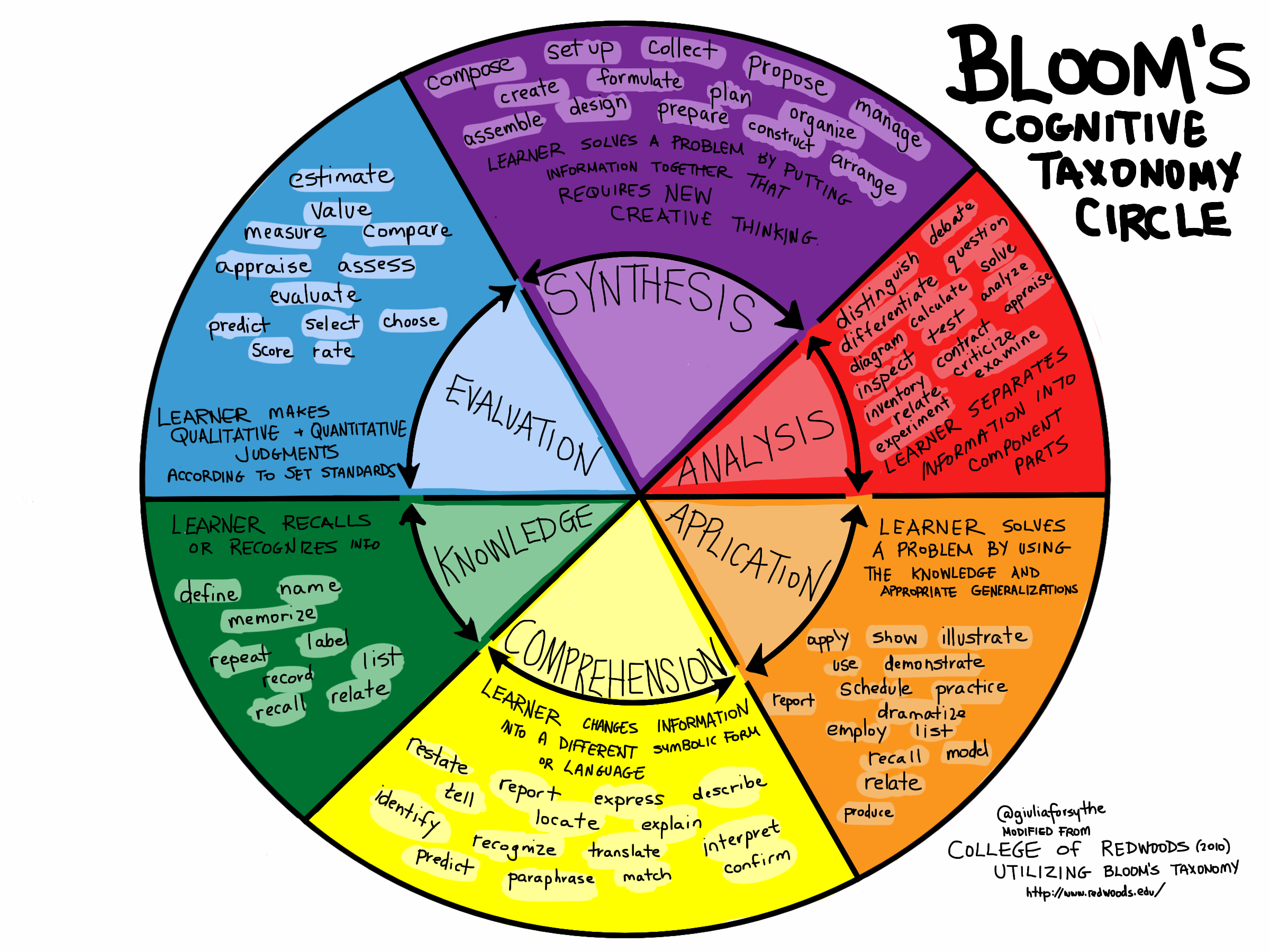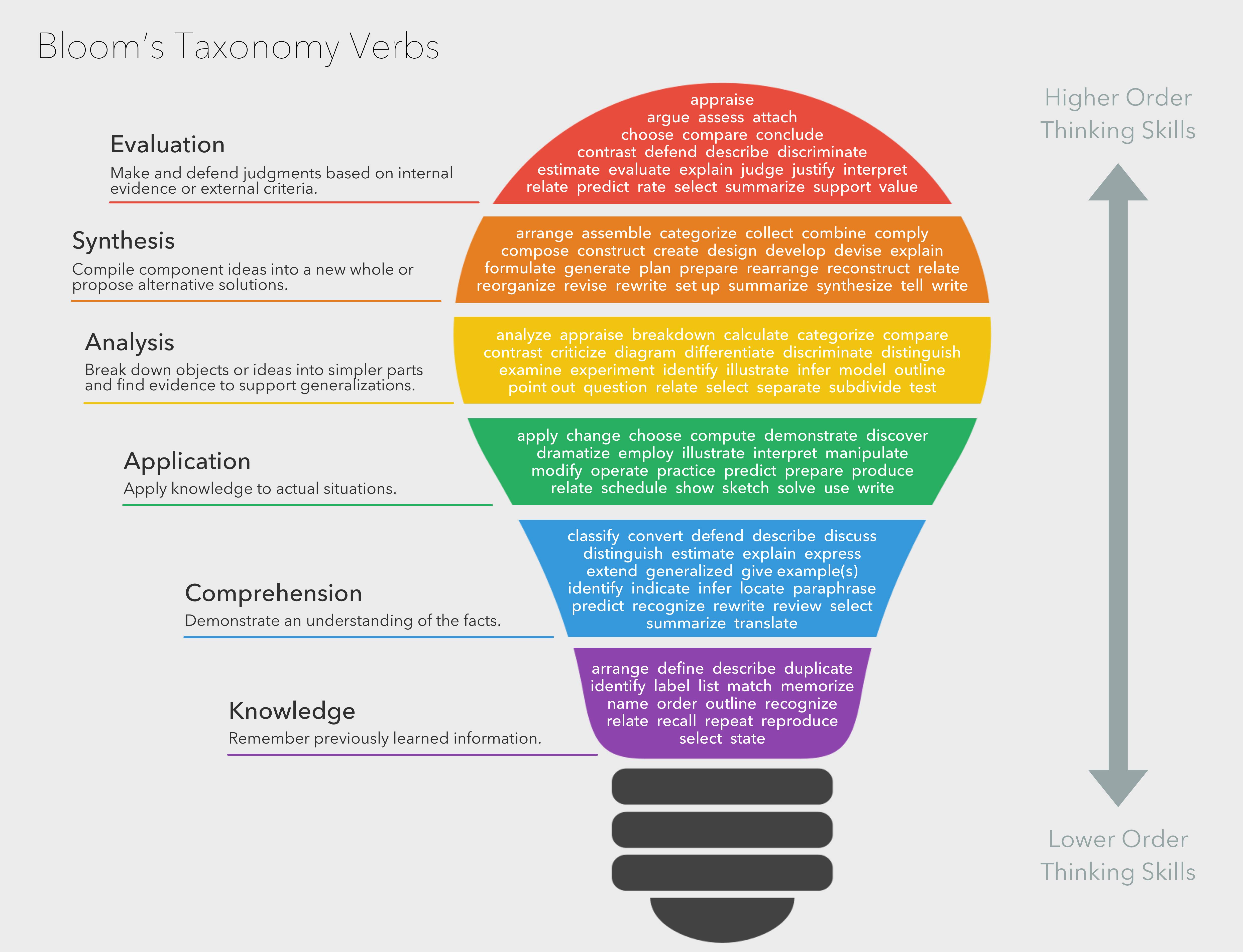Bloom's Taxonomy Printable
Bloom's Taxonomy Printable - The theory is based upon. Web benjamin bloom created a taxonomy of measurable verbs to help us describe and classify observable knowledge, skills, attitudes, behaviors and abilities. In 1956, benjamin bloom headed a group of educational psychologists who developed a classification of levels of intellectual behavior important. The outcome of this study was bloom’s taxonomy of learning (1956). Web revised bloom’s taxonomy action verbs. Web bloom's taxonomy chart features a colorful pyramid concerning the way students learn critical thinking and analysis, starting with knowledge and reaching evaluation. Ad free shipping on qualified orders. In 1956, benjamin bloom with collaborators max englehart, edward furst, walter hill, and david krathwohl published a framework for categorizing educational goals: I will post examples for the next three levels next week. Web benjamin bloom created a taxonomy of measurable verbs to help us describe and classify observable knowledge, skills, attitudes, behaviors and abilities.
Bloom’s ‘Digital’ Taxonomy. A printable reference table by Fractus
The outcome of this study was bloom’s taxonomy of learning (1956). Read customer reviews & find best sellers Browse & discover thousands of brands. Web comprehensive list of bloom's taxonomy verbs for use in ela, math, science, and social studies. Web benjamin bloom created a taxonomy of measurable verbs to help us describe and classify observable knowledge, skills, attitudes, behaviors.
Pin on Kindergarten
Web benjamin bloom led a team of researchers in the 1950s to establish behaviors associated with learning; Web comprehension to show understanding finding in‐ formation from the text. Web benjamin bloom created a taxonomy of measurable verbs to help us describe and classify observable knowledge, skills, attitudes, behaviors and abilities. The six levels in pyramid form in. Free, easy returns.
bloom's taxonomy child development Google Search Blooms taxonomy
Web benjamin bloom led a team of researchers in the 1950s to establish behaviors associated with learning; I will post examples for the next three levels next week. Read customer reviews & find best sellers This table of verbs lists cognitive processes that fit into bloom’s six categories and help identify the cognitive complexity or the order of thinking. Web.
Child friendly Bloom's Taxonomy Teaching, Teaching strategies, Education
Practical recommendations for a wide variety of ways mapping the. Web bloom's taxonomy chart features a colorful pyramid concerning the way students learn critical thinking and analysis, starting with knowledge and reaching evaluation. Web benjamin bloom led a team of researchers in the 1950s to establish behaviors associated with learning; The six levels in pyramid form in. I will post.
BLOOM’S TAXONOMY Knowledge Is Power (by Juan Flores, Miguel Lima and
Web comprehension to show understanding finding in‐ formation from the text. In 1956, benjamin bloom with collaborators max englehart, edward furst, walter hill, and david krathwohl published a framework for categorizing educational goals: I will post examples for the next three levels next week. The theory is based upon. Web below are some examples of questions and prompts for the.
1000+ images about Bloom's Taxonomy on Pinterest
In 1956, benjamin bloom with collaborators max englehart, edward furst, walter hill, and david krathwohl published a framework for categorizing educational goals: This table of verbs lists cognitive processes that fit into bloom’s six categories and help identify the cognitive complexity or the order of thinking. Web bloom’s taxonomy poster #1 includes relevant power verbs and text/media forms that correspond.
Bloom's Taxonomy Verbs Free Classroom Chart
The six levels in pyramid form in. I will post examples for the next three levels next week. Introduction a committee of colleges, led by benjamin bloom, identified three domains of educational activities: In 1956, benjamin bloom headed a group of educational psychologists who developed a classification of levels of intellectual behavior important. Web revised bloom’s taxonomy action verbs.
BLOOM’S TAXONOMY Knowledge Is Power (by Juan Flores, Miguel Lima and
A thorough orientation to the revised taxonomy; In 1956, benjamin bloom headed a group of educational psychologists who developed a classification of levels of intellectual behavior important. Web comprehension to show understanding finding in‐ formation from the text. Free, easy returns on millions of items. Web revised bloom’s taxonomy action verbs.
Bloom’s Taxonomy Gymnastics
Read customer reviews & find best sellers Free, easy returns on millions of items. Web benjamin bloom created a taxonomy of measurable verbs to help us describe and classify observable knowledge, skills, attitudes, behaviors and abilities. Ad free shipping on qualified orders. Web benjamin bloom led a team of researchers in the 1950s to establish behaviors associated with learning;
Pin on Technology in Education
The theory is based upon. Introduction a committee of colleges, led by benjamin bloom, identified three domains of educational activities: Web benjamin bloom created a taxonomy of measurable verbs to help us describe and classify observable knowledge, skills, attitudes, behaviors and abilities. Web anderson,$l.$w.,$&$krathwohl,$d.$r.$(eds.).$(2001).$ataxonomy$for$learning,$teaching$andassessing:$arevisionof$bloom's$taxonomyof$educational$ outcomes:$complete$edition,$new$york$:longman.$ $ anderson&$krathwohl,$ 2001$. Demonstrating basic understanding of facts and ideas.
Read customer reviews & find best sellers Web benjamin bloom created a taxonomy of measurable verbs to help us describe and classify observable knowledge, skills, attitudes, behaviors and abilities. Web comprehensive list of bloom's taxonomy verbs for use in ela, math, science, and social studies. Web bloom's taxonomy chart features a colorful pyramid concerning the way students learn critical thinking and analysis, starting with knowledge and reaching evaluation. Web anderson,$l.$w.,$&$krathwohl,$d.$r.$(eds.).$(2001).$ataxonomy$for$learning,$teaching$andassessing:$arevisionof$bloom's$taxonomyof$educational$ outcomes:$complete$edition,$new$york$:longman.$ $ anderson&$krathwohl,$ 2001$. Web comprehension to show understanding finding in‐ formation from the text. The theory is based upon. A thorough orientation to the revised taxonomy; Web exploring the 6 levels of bloom’s taxonomy bloom's taxonomy is a classification system of learning objectives developed by benjamin bloom in 1956. In 1956, benjamin bloom with collaborators max englehart, edward furst, walter hill, and david krathwohl published a framework for categorizing educational goals: Free, easy returns on millions of items. Web benjamin bloom created a taxonomy of measurable verbs to help us describe and classify observable knowledge, skills, attitudes, behaviors and abilities. The outcome of this study was bloom’s taxonomy of learning (1956). In 1956, benjamin bloom headed a group of educational psychologists who developed a classification of levels of intellectual behavior important. Practical recommendations for a wide variety of ways mapping the. Web revised bloom’s taxonomy action verbs. Web bloom’s taxonomy poster #1 includes relevant power verbs and text/media forms that correspond to each level of the taxonomy: I will post examples for the next three levels next week. Demonstrating basic understanding of facts and ideas. Ad free shipping on qualified orders.









